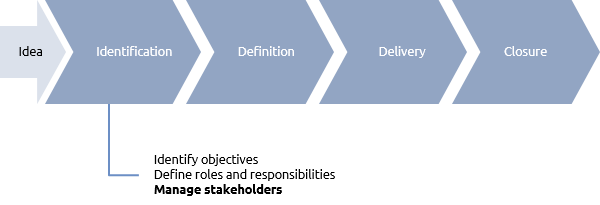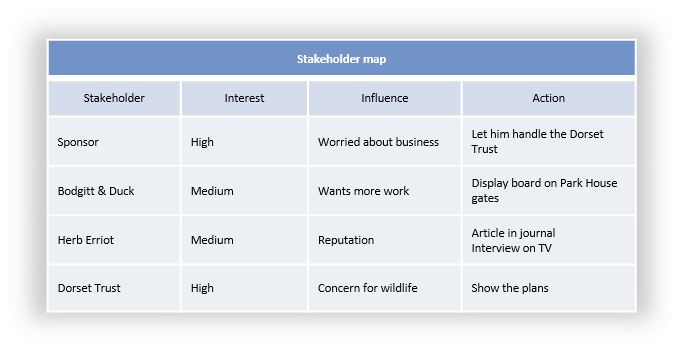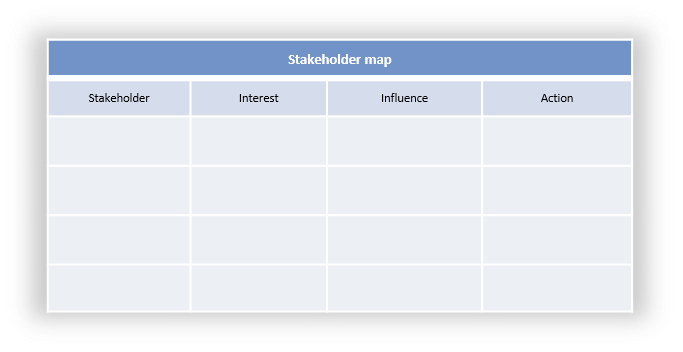
Where are we?
We are still in the project identification phase, trying to understand the project and its environment before we make a commitment to start.
Many project managers lose sight of the fact that it is not the project documentation, however excellent it may be, that actually does the work on the project, it is the human beings that do the work. Even at this early stage in the project you should be thinking about the people in the project, and why they should even bother to help you.
This process, thinking about the key players, and trying to get them onto your side, is called stakeholder management.
A stakeholder can be anyone who will be affected by the project (or its outcome), or who can affect the project. Obviously the project sponsor is a key stakeholder (he/she has a strong vested interested in seeing the project through to completion), but there are other less obvious stakeholders who can influence the success of the project, sometimes in a negative way.
 The point about identifying them is that you can start the process of building them into the project as allies right from the start, rather than having to recover a problem situation later.
The point about identifying them is that you can start the process of building them into the project as allies right from the start, rather than having to recover a problem situation later.
Key players who have been kept well-informed and involved throughout the project are much more likely to act positively when a problem occurs than someone who has been kept in the dark until the bad news breaks.
On many projects the management of stakeholders takes place after the problem has occurred, and often amounts to no more than damage limitation. Of course this is not stakeholder management at all, but a panic reaction towards a group of upset people.
Stakeholder management should be a proactive attempt to get the key players on side, and keep them on side all the way through the project. It is an ongoing process, and must be planned into the project.
On many very large projects skilled professional resources (e.g. Public Relations consultants) would be engaged to focus entirely on this vital aspect of managing the project. On smaller projects it remains the direct responsibility of the project manager.
The process can be split into several parts, as follows:
• Stakeholder identification
• Assessment of interest and influence
• Stakeholder planning
• Stakeholder engagement
We can start these activities now, but we need to keep them under review and revision more or less all the way through the project.
Identifying your stakeholders
Identifying stakeholders can be an opportunity to involve the project team in part of the project management process. This has benefits for you (a wider spread of knowledge and views about the stakeholders), the team (a feeling of involvement in the project) and the stakeholders (possibly more creative ideas for engaging with them).
A brainstorming activity can be undertaken to identify all those who could affect the project and all those on whom the project could have an effect.
Useful documentation will include:
-
The instruction that started the whole thing off, sometimes called the project mandate. This may mention people for whom the project is designed to deliver something
-
The project brief, as this may mention other key players who must be managed proactively
-
Any planning documents you may have (actually you may not have anything documented yet – you may have to revisit your stakeholder communication plan later once you have drafted your schedule in a little more detail)
As in all good brainstorms the initial identification should be completely open and unedited, as sometimes stakeholders appear from the most unlikely sources. Don’t forget people such as:
-
You and the project team members.
-
Your boss, and the line managers of any team members.
-
The sponsor and customer of the project, both at management level and operational level.
-
‘Inspectors’ (many projects will contain an element of conformance to rules or regulations, so the regulator or inspector who signs something off for you can affect your project).
-
Suppliers of goods, services or resources (internal or external).
Assessing their impact
Some stakeholders might have more influence than others, and it is useful to assess your stakeholders in this regard (it will help you to work out a priority system for your actions).
Keep it simple. Use a high/medium/low method, and be realistic about the influence that each one could have (it is common to assess too many as high, as we may fear the worst!). Start to build up a stakeholder map.
Communication planning
You must now try to identify just what each stakeholder desires from the project, and what might be their attitude towards the project.
This could be done by brainstorm, by asking other project managers who know the stakeholders, or even by asking the stakeholders directly.
It can be surprising what individual stakeholders actually want. Many bosses, for example, want a quiet life, punctuated by good news. It can be poor management to keep such a boss inundated with news of every penny of expenditure, and every activity undertaken.
In an ideal world you might be able to satisfy the needs of every individual stakeholder, but this is rarely possible.
However, do not despair. If you can demonstrate how:
- you have listened to and taken notice of their points of interest;
- tried to deliver what they want;
- but for reasons that you can explain you cannot meet their needs on this project;
then this is almost as good as actually meeting their needs.
Stakeholder engagement
Once you have taken the trouble to produce this stakeholder analysis it would be ridiculous not to put it into action, so you must develop a list of extra activities you will carry out (yes, they will probably fall into your lap for execution) to proactively engage with your stakeholders. These actions must be real and positive, not woolly statements such as ‘do not upset them’.
Typical actions might include:
- Involving a stakeholder in some of the training associated with your project.
- Inviting a stakeholder to a demonstration of something working to specification.
- Inviting a stakeholder to take responsibility for something on the project, such as publicity.
- Discussing your risk management approach with them, and asking for suggestions.
- Making sure you communicate with them, in ways which suit them.
As the project unfolds the communication plan should be reviewed at regular intervals, as some stakeholders will lose their importance, and some new ones will appear. This will form a vital piece of information for the project team, and for all future projects. As such it should be filed away at the end of the project, for future reference.
The Lake project stakeholder map might look like this:

Summary
You can forestall many problems with stakeholders in and around your project by managing them in a proactive manner. You cannot leave their positive support for your project to chance, you must manage your stakeholders.
Checklist
List all stakeholders | Even the unlikely ones |
Assess their potential influence | Be realistic – not all stakeholders are high influence |
Identify likely interests in the project | Maybe ask them |
Identify management actions (to engage with your stakeholders) | And build these into your plan |
Replan the project | These stakeholder management activities will cost someone (probably you) some effort, so keep your documentation up-to-date |
Review and revise regularly throughout the project | You will not be able to see all the stakeholders at the outset |
Further reading
These links to the Praxis web site explain how the concepts introduced in this chapter can be applied to projects that involve more people and more complex relationships.
The main Praxis page for stakeholder management with additional pages on competency and organisational maturity. | |
Stakeholders need to be influenced to gain and maximise their support – this page explains the principles of influencing | |
An encyclopaedia page that provides some additional ideas on mapping stakeholders. |
Thanks to Mike Watson of Obsideo for providing this book






